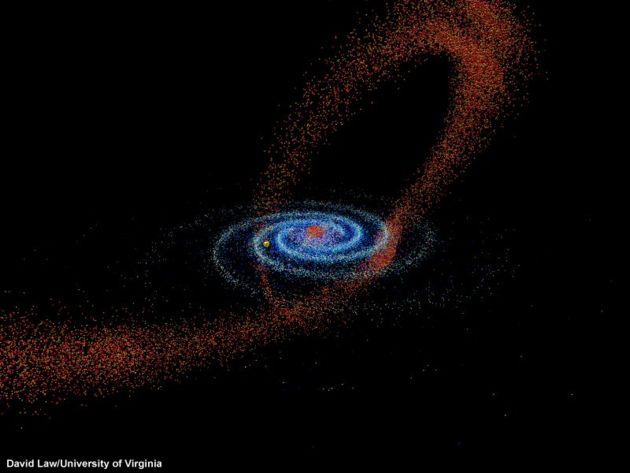 Scientists Now Know: We're Not From Here!
Imagine the shock of growing up in a loving family with people you call "Mum" and "Dad" and then, suddenly, learning that you are actually adopted! This same sense of shock came as scientists announced that the Sun, the Moon, our planet and its siblings, were not born into the familiar band of stars known as the Milky Way galaxy, but we actually belong to a strange formation with the unfamiliar name of the Sagittarius Dwarf galaxy! How can this be? Using volumes of data from the Two-Micron All Sky Survey (2MASS), a major project to survey the sky in infrared light led by the University of Massachusetts, the astronomers are answering questions that have baffled scientists for decades and proving that our own Milky Way is consuming one of its neighbors in a dramatic display of ongoing galactic cannibalism. The study published in the Astrophysical Journal, is the first to map the full extent of the Sagittarius galaxy and show in visually vivid detail how its debris wraps around and passes through our Milky Way. Sagittarius is 10,000 times smaller in mass than the Milky Way, so it is getting stretched out, torn apart and gobbled up by the bigger Milky Way.
 A new infra red digital survey of the entire sky was made in 2003. Teams from the universities of Virginia and Massachusetts used a supercomputer to sort through half a billion stars to create a -- NEW STAR MAP showing our Solar System (yellow circle) to be at the exact nexus crossroads where two galaxies are actually joining. "It's clear who's the bully in the interaction," said Steven Majewski, U.Va. professor of astronomy and lead author on the paper describing the results. "If people had infrared-sensitive eyes, the entrails of Sagittarius would be a prominent fixture sweeping across our sky," Majewski said. "But at human, visual wavelengths, they become buried among countless intervening stars and obscuring dust. The great expanse of the Sagittarius system has been hidden from view."
Not any more. By using infrared maps, the astronomers filtered away millions of foreground stars to focus on a type of star called an M giant. These large, infrared-bright stars are populous in the Sagittarius galaxy but uncommon in the outer Milky Way. The 2MASS infrared map of M giant stars analyzed by Majewski and collaborators is the first to give a complete view of the Milky Way galaxy's meal of Sagittarius stars, now wrapping like a spaghetti noodle around the Milky Way. Prior to this work, astronomers had detected only a few scattered pieces of the disrupted Sagittarius dwarf. Even the existence of Sagittarius, except in the field of Astrology and horoscopes, was unknown until the heart of this nearest satellite galaxy of the Milky Way was discovered by a British team of astronomers in 1994. The fact that the Milky Way is seen in the sky at an angle has always puzzled astronomers. If we originated from the Milky Way, we ought to be oriented to the galaxy's ecliptic, with the planets aligned around our Sun in much the same angle as our Sun aligns with the Milky Way. Instead, as first suggested by researcher Matthew Perkins Erwin, the odd angle suggests that our Sun is influenced by some other system. Together with data from the Two-Micron All Sky Survey we now know what it is. We actually belong to the Sagittarius Dwarf galaxy.
"We sifted several thousand interesting stars from a catalog of half a billion," said co-author Michael Skrutskie, U.Va. professor of astronomy and principal investigator for the 2MASS project. "By tuning our maps of the sky to the 'right' kind of star, the Sagittarius system jumped into view."  We are from another galaxy in the process of joining with the Milky Way. The Milky Way is actually not our parent galaxy. The mystery of why the Milky Way has always been sideways in the night sky has never been answered -- until now.
|